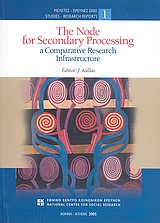
The Node for Secondary Processing
A Comparative Research Infrastructure Τύπος: ΒιβλίοΣυγγραφέας: Στογιάνοβα, Μάγια / Τζωρτζοπούλου, Μαρία / Καφετζής, Παναγιώτης / Ρόμπορας, Αναστάσιος / Κακεπάκη, Μανίνα / Βαλάση, Δέσποινα / Χατζηγιάννη, Ανδρομάχη / Τσίγγανου, Ιωάννα / Κονδύλη, Δήμητρα / Καππή, Χρυσούλα / Λιναδρής, Απόστολος / Φρυδάκης, Μάριος / Κάλλας, Γιάννης / Συλλογικό έργο,
Επιμελητής: Κάλλας, Γιάννης
Εκδόσεις: Εθνικό Κέντρο Κοινωνικών Ερευνών
- Χρονολογία Έκδοσης: 2005
- Σελίδες: 184
- ISBN-13: 978-960-7093-88-2
- Διαθεσιμότητα: **Αποστέλλεται κατόπιν παραγγελίας σε 2-4 ημέρες και εφόσον υπάρχει στον εκδότη
αρχική τιμή:
Globalisation and the integration of Europe increase the importance of comparative social research. The design of comparative research in Europe can be based on one of two alternative strategies. The first one is to produce the raw data needed for the different European countries under one comparative research programme and then make this data available to the research community. The second one is to continuously collect data produced under different and autonomous research projects, to harmonise and to, integrate them into large data collections. This second strategy has not been given systematic support until now, because we lack the appropriate research infrastructure.
Social phenomena are defined by the context of those conducting the surveys. Therefore the statistical runs available for the study of given phenomena are almost always far too inadequate to lay the foundation for of a valid introduction. A solution to this problem will be to accumulate data referring to the same phenomena and try to integrate it and make it available for secondary analysis.
The book presents some main issues related to the design of the Node for Secondary Processing (NSP), which is a metadata management system able to support secondary data processing in social sciences. One of the main requirements, for a research infrastructure able to support comparative research, is its ability to integrate more than one surveys in one subject matter database. The NSP supports this integration with the environment and the tools needed for this task.
As a great number of the metadata, produced during the development of a subject matter database, should be considered as elements of an ever changing environment, the only way to build a system like the NSP is to simultaneously develop at least some subject matter databases. That is why a number of subject matter databases is also described in the book. Of course the development of these subject matter databases has not been exhausted, and continues to be an ongoing effort.
| ISBN13: | 978-960-7093-88-2 |
| Συγγραφέας: | Συλλογικό έργο |
| Εκδότης: | Εθνικό Κέντρο Κοινωνικών Ερευνών |
| Χρονολογία Έκδοσης: | 2005 |
| Σελίδες: | 184 |
| Εξώφυλλο: | Μαλακό εξώφυλλο |
| Σχήμα: | 24χ17 |
| Διαθεσιμότητα: | Κυκλοφορεί |
| Βάρος: | 407 γραμμάρια |
| Είδος: | Βιβλίο |
| Σειρά: | Μελέτες - Έρευνες = Studies - Research Reports |






















